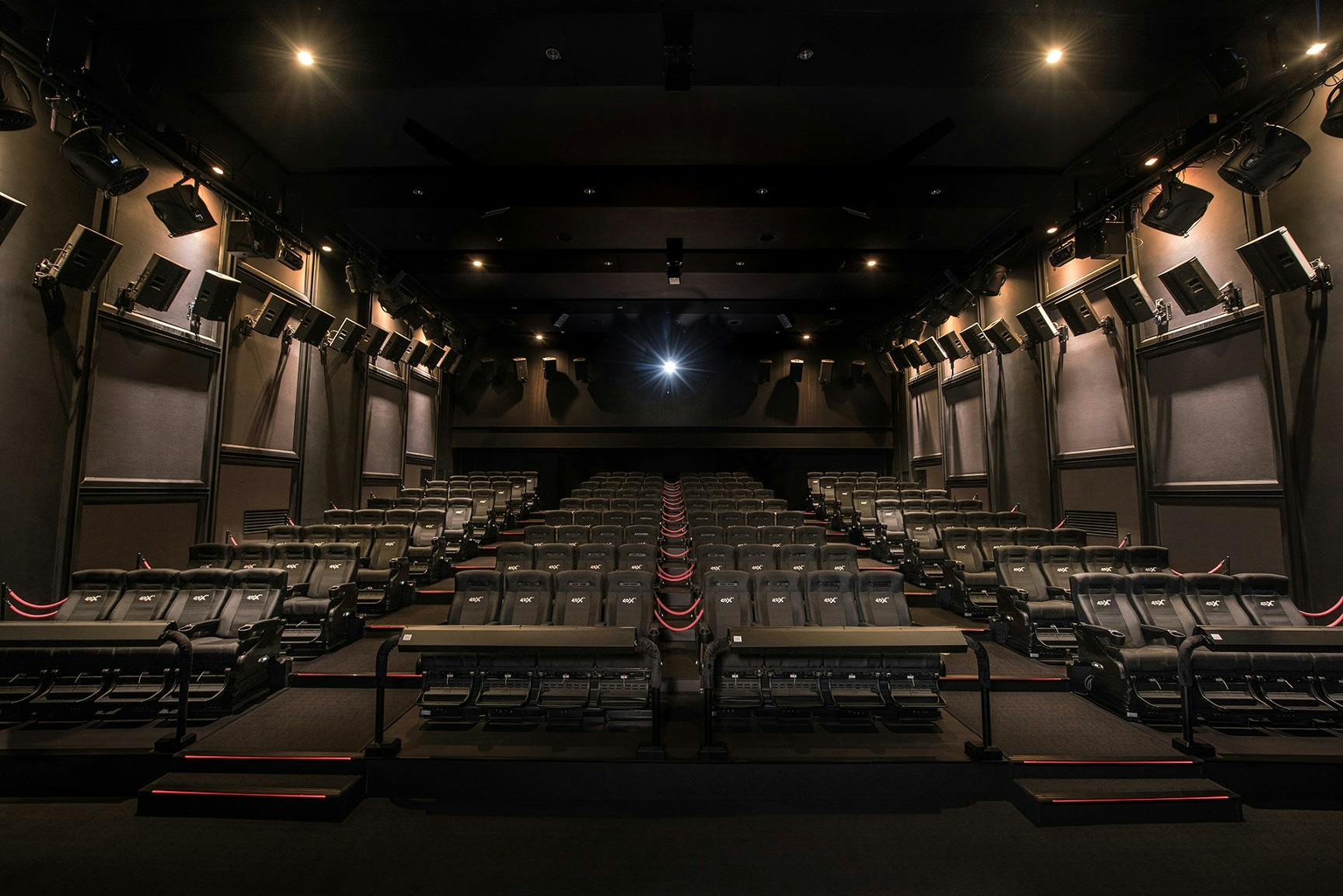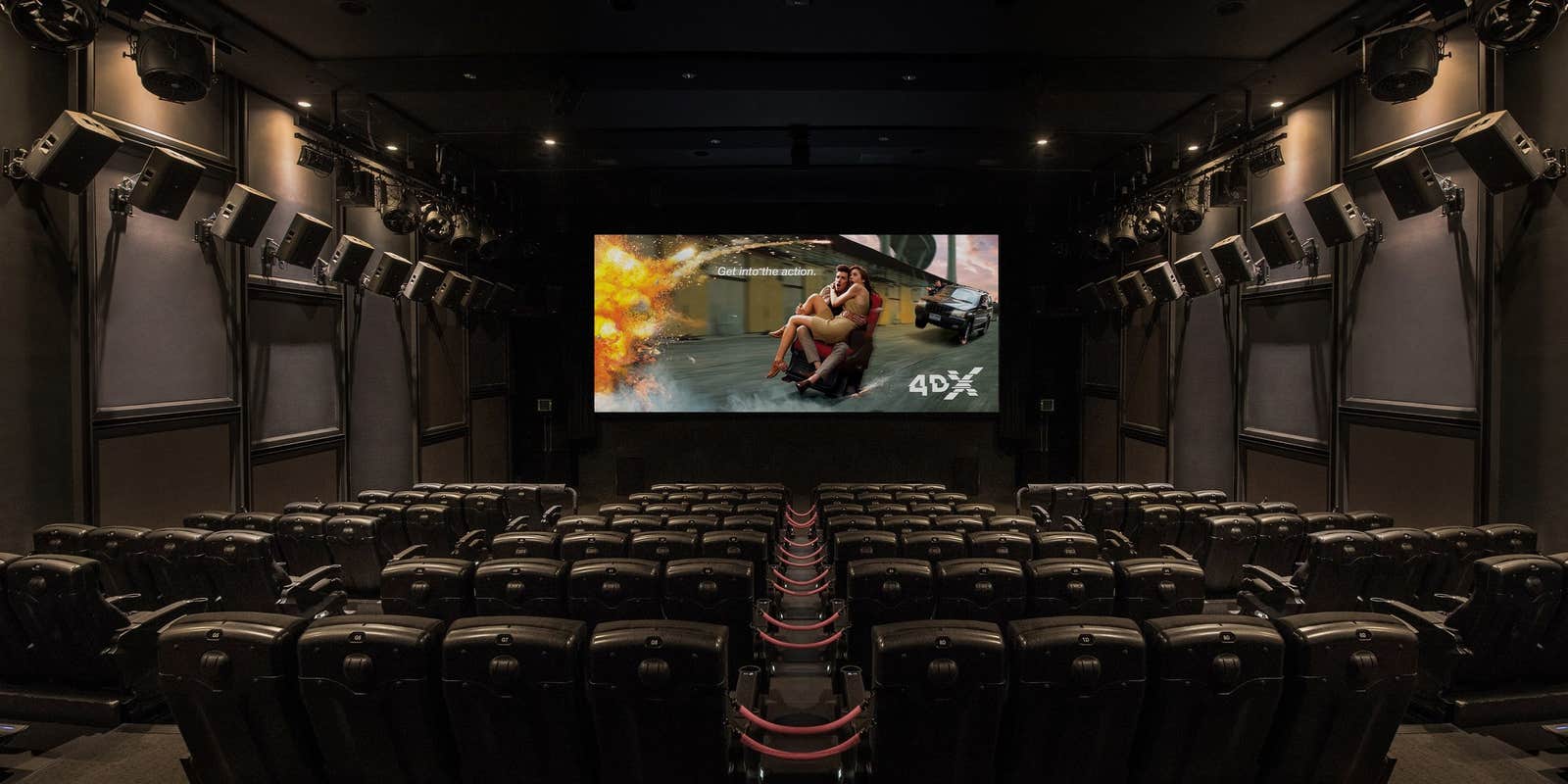4DX is a product of the current blockbuster era, a service that turns movies into theme park rides. Expanding across more than 60 countries, 4DX theaters offer chairs that sway and vibrate along with the action onscreen, spray air and water onto the audience, emit scents at opportune moments, and occasionally punch you in the back during fight scenes. The 4DX website advertises a dizzying array of lesser-known effects including lightning, bubbles, and a “bottom tickler.”
Similar technology has existed for decades in actual theme parks (James Cameron directed a Terminator 2 tie-in for Universal Studios in the ’90s), but 4D movies only became a profitable mainstream enterprise in the Marvel era, when studios began releasing as many blockbuster sequels as possible. The Korea-based 4DX company is the main purveyor of motion-enhanced 4D movies, adapting dozens of titles each year—mostly action/adventure films like Avengers: Endgame and Alita: Battle Angel.
As you might expect, 4DX movies are a love-it-or-hate-it phenomenon. Some people find it exciting and immersive to swerve and jolt around like you’re inside the cars of Fast and Furious, while others find it distracting. And since critics rarely review 4D movies, you basically have to try them and decide for yourself, with tickets going for around $30 each.

How are 4DX movies made?
The growing popularity of 4DX movies raises some questions about their conception. How much are the original filmmakers involved? James Cameron was (as usual) ahead of the curve, and you can imagine Robert Rodriguez or James Gunn getting excited about multisensory special effects, but Christopher Nolan? Maybe not. On an artistic level, how do you enhance the viewer’s experience beyond obvious choices like moving the chairs in time with a car chase? To get some insight into the creative process behind a 4DX movie, the Daily Dot spoke to 4DX’s art director Michael Martinez, who has worked on numerous films, including The Last Jedi and Aquaman.
The Daily Dot: I thought I’d start by asking a little about how 4DX works. What’s your job, and how does your team work on the films that you’re developing?
Michael Martinez: I am leading the team of editors here to design all the 4D effects and motion for each of our feature titles, trailers, and so on. It’s a complicated process, but to simplify it, we receive our assets, and we have only a certain amount of time to work. A feature film is typically about two weeks; anything beyond that is a dream come true. Once the editors are done with their draft, we’ll bring in the studios. Could be anyone from Disney or Universal, those studio reps come in, and they ultimately have the final say for what gets distributed out to our sites worldwide.
DD: How do you find a balance between making sure you have an immersive experience and not distracting from the film?
MM: It really depends on the film. You’ve got your horror films, your action/adventure, mysteries. Obviously our goal is not to distract the audience. We want to make it as seamless as possible, as natural as possible, and not distract from the director’s intentions. [Horror] movies typically have a more tense feeling throughout, as opposed to a movie like Godzilla that’s just wall-to-wall action, so there’s different elements we take into consideration. There’s direction, there’s continuity, there’s energy, there’s strength, scale, panning, character motion.
With direction, let’s say you have a movie like Fast and Furious where you have a shot where someone veers left, and then the next shot it’s the same thing. At some point you’ve gotta know when to return the seat back to normal. Then there’s continuity. The seats follow camera pans, so let’s say you have a camera pan over a large landscape, and then you cut to people talking… instead of moving and stopping the chairs, in that situation we’d make it continuous.
In a movie like Avengers, there’s constant action going on. There’s scenes where all the Avengers are fighting Thanos, obviously there’s all kinds of action from each character, as opposed to a movie like La Llorona, where there’s nothing there and all of a sudden the house starts shaking. That could be an element of surprise. We try to mimic those moods as best as we can. Then there’s character motion. With movies like Toy Story, there’s little motions from toys, there’s motions that we try to play up, and jokes. And going back to Godzilla again, with giant footsteps, there’s a big difference in scale.
READ MORE:
- Is Lashana Lynch really playing 007 in the new Bond movie?
- The true villain of ‘Spider-Man: Far From Home’ is fake news
- Every ‘X-Men’ movie, ranked from best to worst
MM: With scents, we typically try to keep that in the foundation of the scene. If you have characters arriving on a new planet, you want to establish that. Like Guardians of the Galaxy Vol. 2 when they go to Kurt Russell’s planet. It’s kind of like a flowery planet, so of course we’re going to incorporate that flowery scent. You have a movie like Beauty and the Beast, the rose is a natural, central character of the movie. Obviously if there’s points in a scene where people actually smell things, we’re going to incorporate the scent effect.
DD: You mentioned earlier about working with studios. Can you give some examples of that, or maybe filmmakers you’ve worked with? I assume some directors are involved in the process, but some aren’t.
MM: Yeah, it’s a rare case but sometimes we get lucky. It’s usually the studio reps that come in, anyone from a film editor to a producer, to post-production supervisors. On a rare occasion we get the filmmakers, but our process is the same; they have the final say. Those studio reps will come in, we’ll watch the movie in full. If they don’t want a scent in there, we take it out. They don’t want a vibration in there, we take it out. They want to add things, we have to add them.
DD: Looking at the list of 4DX movies, they’re mostly blockbuster franchise films, but one sprung out to me, and that’s Dunkirk. It’s a big action film, but it’s also very serious. Were you involved?
MM: I was actually doing effects for that one, that was a couple of years ago now. It was a great experience. There’s a lot of tension in that film. We tried to treat it as delicately as we could. We knew the gravity of that movie. A lot of the underlying vibrations for every single boat scene, that’s something we wanted to tame down as much as we could. We didn’t want to take people out. As opposed to the airplane scenes, those we definitely tried to rev up as much as we could. There’s a lot of airstrike sequences there.
DD: 4DX feels like something that grew out of the current climate for big blockbusters, but can you imagine it being used on other kinds of film in the future? Would you be interested in doing dramas, and can you think of what that would be like?
MM: We’ve done that in the past, actually. We’ve done a movie called The Disaster Artist, which is somewhat of a comedy but more drama. The feeling of that movie isn’t on a grand scale like Avengers. It’s very dialogue-heavy. You have scenes like the club scene where they go dancing… We have subwoofers in our chairs, you have club music going on, of course you’re going to incorporate the subwoofers. There’s a little bit of dance motion going on there, but nothing too crazy. There’s a lot of camera pans, and obviously there’s driving sequences, but overall the movie’s very tame. The film in general is dialogue-driven so we don’t want to overbear the audience and distract people.
READ MORE:
- ‘Spider-Man: Far From Home’ is a hilarious teen comedy with a great villain
- Indie drama ‘The Farewell’ beats ‘Avengers: Endgame’ box office record
- ‘Alita: Battle Angel’ is a surprisingly fun teen adventure
Want more reviews and interviews from Gavia Baker-Whitelaw? Sign up here to receive her biweekly geek culture newsletter.


